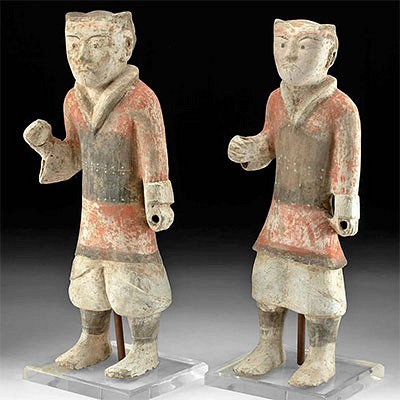Prehistoric Anasazi Red Mesa Black-on-White Bowl
Lot 124
About Seller
Artemis Gallery
686 S Taylor Ave, Ste 106
Louisville, CO 80027
United States
Selling antiquities, ancient and ethnographic art online since 1993, Artemis Gallery specializes in Classical Antiquities (Egyptian, Greek, Roman, Near Eastern), Asian, Pre-Columbian, African / Tribal / Oceanographic art. Our extensive inventory includes pottery, stone, metal, wood, glass and textil...Read more
Categories
Estimate:
$1,600 - $2,400
Absentee vs Live bid
Two ways to bid:
- Leave a max absentee bid and the platform will bid on your behalf up to your maximum bid during the live auction.
- Bid live during the auction and your bids will be submitted real-time to the auctioneer.
Bid Increments
| Price | Bid Increment |
|---|---|
| $0 | $25 |
| $300 | $50 |
| $1,000 | $100 |
| $2,000 | $250 |
| $5,000 | $500 |
| $10,000 | $1,000 |
| $20,000 | $2,500 |
| $50,000 | $5,000 |
| $100,000 | $10,000 |
| $200,000 | $20,000 |
About Auction
By Artemis Gallery
May 25, 2023
Set Reminder
2023-05-25 10:00:00
2023-05-25 10:00:00
America/New_York
Bidsquare
Bidsquare : ON-SALE! Antiquities, Pre-Columbian, Ethno, Fine Art
https://www.bidsquare.com/auctions/artemis-gallery/on-sale-antiquities-pre-columbian-ethno-fine-art-12860
ON-SALE Antiquities, Pre-Columbian, Ethno, More! Artemis Gallery info@artemisgallery.com
ON-SALE Antiquities, Pre-Columbian, Ethno, More! Artemis Gallery info@artemisgallery.com
- Lot Description
Native American, Four Corners region, Southern Colorado Plateau, Pueblo I / Pueblo II (Anasazi) period, ca. 875 to 1050 CE. A ceramic bowl, painted in the style most commonly excavated at the great Anasazi city of Chaco Canyon and known as Red Mesa Black-on-White. Contrasting the light gray exterior, the interior is painted with black-on-white decoration of geometric motifs in a manner resembling cross-stitching. The geometric patterns are comprised of alternating triangles that may represent clouds. These painted designs are well done, with tiny embellishments of ticked lines; interlocking patterns that are evenly spaced give it a pleasing, rather than busy design. Size: 9.75" L x 9" W x 4.4" H (24.8 cm x 22.9 cm x 11.2 cm)
Pottery of this kind is some of the most important found in the ancient Southwest. The Chaco Project recovered more of this pottery than any other style. Chaco was the center of the ancestral Puebloan (Anasazi) culture, a vast city of monumental architecture, including massive stone Great Houses of multiple stories and kivas of all sizes. Roads from Chaco Canyon radiated to outlying settlements for hundreds of miles, and it was a religious, social, and trade hub for a vast region. Today many Native peoples in the Southwest connect their own histories to Chaco, seeing it as a stop along their sacred migrations.
Provenance: private New Jersey, USA collection purchased in 2015; ex-Dr. J. Mitchell Prudden collection, Adark collection
All items legal to buy/sell under U.S. Statute covering cultural patrimony Code 2600, CHAPTER 14, and are guaranteed to be as described or your money back.
A Certificate of Authenticity will accompany all winning bids.
We ship worldwide and handle all shipping in-house for your convenience.
#178850Professionally repaired with break lines visible and a small area of the rim restored. Some nicks to rim and abrasions and pitting to surface as shown, as well as fire-darkening to exterior. Otherwise, very nice presentation with good remaining pigments.Condition
- Shipping Info
-
All shipping is handled in-house for your convenience. Your invoice from Artemis Gallery will include shipping calculation instructions. If in doubt, please inquire BEFORE bidding for estimated shipping costs for individual items.
-
- Buyer's Premium



 EUR
EUR CAD
CAD AUD
AUD GBP
GBP MXN
MXN HKD
HKD CNY
CNY MYR
MYR SEK
SEK SGD
SGD CHF
CHF THB
THB














